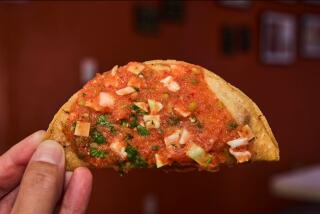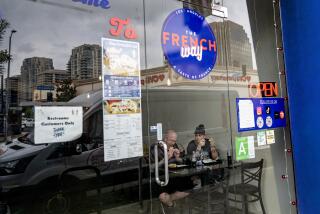Colorful Basque Fishing Village Was a Favorite of the Sun King
- Share via
ST. JEAN DE LUZ, France — One look at the azure crescent bay, colorful harbor and cloudless skies makes you realize why this place has remained the perfect little Basque fishing village, one favored by Louis XIV for the Sun King’s marriage to the Spanish infanta in 1660.
Basques have always been great fishermen, claiming to have discovered Newfoundland in pre-Columbian 1372 as their ships roamed the Atlantic Ocean in search of cod.
Fishing, however, wasn’t the only pursuit of intrepid Basque mariners, who also did more than their share of privateering. The Basques were described by a 16th-Century Spanish author as “very bellicose, especially at sea.”
Bellicose or benign, the British have always had a covetous eye for southwest France, at least since Henry II in the 12th Century. Wellington camped out here in 1814 on his way to finish off Napoleon at Waterloo. And half a century later it was a preferred watering hole for upper-crust Britons.
St. Jean de Luz is still a preferred spot for French and foreign visitors, having the climate, lovely beach, fine old architecture and clutch of tempting Basque restaurants that add up to a memorable holiday.
Getting here: Fly Air France nonstop to Paris. Or Air Canada, American, TWA Pan Am, Delta or Continental with changes. Take Air Inter on to Biarritz in an hour. From there it’s nine miles down the coast to St. Jean de Luz.
How long/how much? Europeans and the British usually stay a fortnight. But two or three days will do for the town, another for forays into the surrounding Basque country. Accommodations are very reasonable, dining moderate to expensive.
Few fast facts: The French franc recently traded at 16 cents, 6.25 to the dollar. Late May until late autumn are the best times for a visit, but August is the month all France hits the road for vacations. You need good walking shoes. You also need a visa.
Getting settled: Hotel Basque (Rond Point de Sainte-Barbe; $46 to $65 U.S. double) is on the edge of town on a cliff above the Atlantic. Above prices are for rooms in the main building; other two-room bungalows with kitchens, also on the beautiful grounds, $88.
The buildings and all furnishings are in Basque style, with fig trees around the property and a three-hole golf course outside your room. La Reserve restaurant is where you may take full or half-pension.
Ohartzia (28 Rue Garat; $44 to $49 double) is a 17-room hotel at town center, modest but very neat and close to the harbor, beach and main shopping street. Bedrooms are on the small side, baths are fine. In a private little garden in the rear you may take breakfast, the only meal served. Off the minuscule lobby you’ll find a bright living room with fireplace, games and lots of magazines.
La Deviniere (5 Rue Loquin; $57-$106 double) also enjoys a good central location. It’s an enchanting little place completely done over by the owner, a former antiques dealer. Floors are of tile, with museum-quality rugs and furniture throughout. There’s a small library with grand piano and fireplace, and a grassy courtyard with white lawn furniture and lots of flowers.
Bedrooms are furnished differently, with traditional fabrics and fine antiques. La Deviniere will capture your heart immediately.
Regional food and drink: Basques like to start a meal with an hors d’oeuvre or first course of piperade, a melange of peppers, tomatoes and onions cooked with eggs, often served with ham or cipolatas, small local sausages. Tuna, anchovies and sardines are grilled simply, or figure into other local dishes, while merlu (a type of whiting or hake) is a Basque favorite.
Bayonne’s ham is world renowned, the gateau Basque (a flat almond cake) almost so. As St. Jean de Luz is only a few miles from Spain, many locals drink sangria in the summer, which is made here with wine, fruits and cognac. Irouliguy is a hearty Basque wine, with the red version much favored here.
Moderate-cost dining: Le Kayola (18 Rue de la Republique) is an indoor-outdoor place on a street with many similar restaurants. After entrees of piperade with ham, we had the fruits de mer en papillote and merlu koskera (in the manner of a fisherwoman). The last is a town specialty, a generous fillet of merlu under a sauce of peas, asparagus and mussels. Delicious.
The kitchen also does an excellent chicken basque (with a piquant sauce of peppers, tomatoes and onions) and chipirons (cuttlefish) in its own ink, very black, but again delicious. A pair of young men come along the street with guitar and flute to entertain during lunch and dinner hours. Very festive.
Just down the street at No. 17 you’ll find what many consider the best seafood restaurant in town, Kaiku. Step down into a cellar room with stone walls and tile floors and you’re sure to see the town trenchermen holding forth over oysters, sole, lobster, barbue (a type of brill or sand dab) and rouget (red mullet), all prepared and served simply. Lobster soup is a specialty. About $31 for a huge lobster-shellfish lunch or dinner for two at Kaiku. It’s worth every sou.
La Reserve (Hotel Basque) has a classic French kitchen with Basque overtones. Dine on a broad terrace with views of the ocean and hills, or inside where the room is done in shades of peach, with lots of crystal and flowered china.
A three-course luncheon costs about $18, including perhaps a fish soup or crudites as a first course, followed by young rabbit sauteed in a pesto sauce, grilled salmon or steak au poivre, finishing with the cheese board or a dessert.
Going first-class: Le Grand Hotel (43 Blvd. Thiers; $106-$147 double low season, $147-$180 high) lives up to its name. It’s a formal place with marble floors and walls, Edwardian-style winter garden, lovely rooftop pool and handsome bedrooms in soft pinks and grays, and fresh roses by beds.
The Grande Carte dining room is a huge Edwardian rotunda with marvelous views of the bay and mountains.
On your own: Start with a stroll down Rue Gambetta, a pedestrian street with the best shops. Then have a cafe filtre or cooling drink at a table beneath plane trees on Place Louis XIV. This is the heart of St. Jean de Luz, opposite the port, where band concerts and Basque dancing groups hold forth in summer.
Visit the 14th-Century John the Baptist Church, said to be the most beautiful in Basque country, where Louis and the Spanish princess were married. Then haul your clubs to one of the two 18-hole golf courses for a round.
Take your pick of water sports: surfing, lazing on the beach, diving, windsurfing. Or sign up for deep-sea fishing in the Atlantic in one of the boats that sail regularly from the harbor.
One of the real joys of visiting Basque country is a sojourn to the villages in the Pyrenees foothills southeast of St. Jean. We always stop in at Ascain (four miles) to watch an informal but spirited game of pelote that is usually going on in the square. Ainhoa (14 miles) is noted for its colorful main street, with 17th- and 18th-Century Basque architecture.
For more information: Call the French National Tourist Office at (213) 271-6665 or (213) 272-2661 for a brochure and map on southwest France, another on accommodations in the region. Ask for the St. Jean de Luz package. French National Railroads at (213) 274-6934 will send information on French rail passes.
More to Read
Sign up for The Wild
We’ll help you find the best places to hike, bike and run, as well as the perfect silent spots for meditation and yoga.
You may occasionally receive promotional content from the Los Angeles Times.






